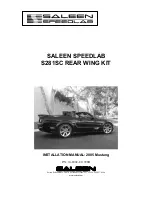
A scorching odor may be detected if you continue to run
a malfunctioning engine. The odor may indicate severe
and abnormal catalyst overheating. If this occurs, the
vehicle should be stopped, the engine shut off and the
vehicle allowed to cool. Service, including a tune-up to
manufacturer’s specifications should be obtained imme-
diately.
To minimize the possibility of catalyst damage:
•
Do not shut off the engine or interrupt the ignition
when the transmission is in gear and the vehicle is in
motion.
•
Do not try to start engine by pushing or towing the
vehicle.
•
Do not idle the engine with any spark plug wires
disconnected or removed, such as when diagnostic
testing, or for prolonged periods during very rough
idling or malfunctioning operating conditions.
VEHICLE LOADING
Certification Label
As required by National Highway Traffic Safety Admin-
istration Regulations, your vehicle has a certification
label affixed to the driver’s side door or pillar.
This label contains the month and year of manufacture,
Gross Vehicle Weight Rating (GVWR), Gross Axle Weight
Rating (GAWR) front and rear, and Vehicle Identification
Number (VIN). A Month-Day-Hour (MDH) number is
included on this label and indicates the Month, Day and
Hour of manufacture. The bar code that appears on the
bottom of the label is your Vehicle Identification Number
(VIN).
Gross Vehicle Weight Rating (GVWR)
The GVWR is the total permissible weight of your vehicle
including driver, passengers, vehicle, options and cargo.
The label also specifies maximum capacities of front and
324
STARTING AND OPERATING
Summary of Contents for Ram Power Wagon
Page 2: ......
Page 8: ......
Page 40: ...Inserting Latch Plate In Use Position 40 THINGS TO KNOW BEFORE STARTING YOUR VEHICLE...
Page 68: ...Quad Cab Tether Strap Mounting 68 THINGS TO KNOW BEFORE STARTING YOUR VEHICLE...
Page 74: ......
Page 89: ...Blindspot Mirror Trailer Towing Position UNDERSTANDING THE FEATURES OF YOUR VEHICLE 89 3...
Page 110: ...110 UNDERSTANDING THE FEATURES OF YOUR VEHICLE...
Page 111: ...UNDERSTANDING THE FEATURES OF YOUR VEHICLE 111 3...
Page 112: ...112 UNDERSTANDING THE FEATURES OF YOUR VEHICLE...
Page 166: ...INSTRUMENTS AND CONTROLS 166 UNDERSTANDING YOUR INSTRUMENT PANEL...
Page 167: ...INSTRUMENT CLUSTER UNDERSTANDING YOUR INSTRUMENT PANEL 167 4...
Page 226: ...Operating Tips Chart 226 UNDERSTANDING YOUR INSTRUMENT PANEL...
Page 237: ...Angles A B C and D STARTING AND OPERATING 237 5...
Page 258: ...UNDERSTANDING THE FEATURES OF YOUR WINCH Winch Components 258 STARTING AND OPERATING...
Page 304: ...304 STARTING AND OPERATING...
Page 362: ......
Page 366: ...ENGINE COMPARTMENT 5 7L 366 MAINTAINING YOUR VEHICLE...
Page 420: ......
Page 450: ......
Page 451: ...INDEX 10...
















































